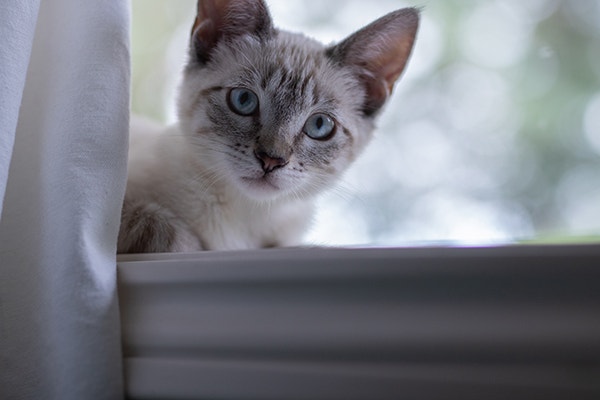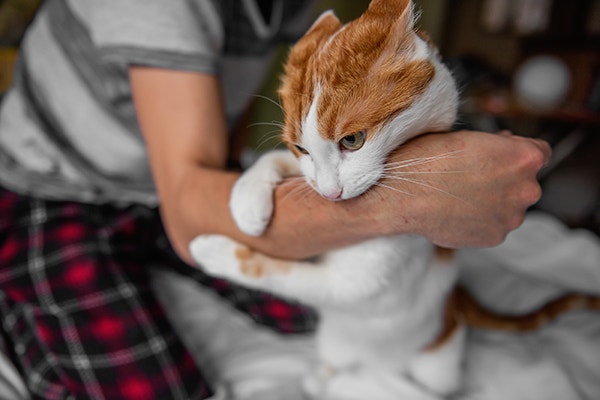- Homepage
- Blog
- Bonding & Care
- Travelling With A Cat Test
How to travel with a cat: A stress-free guide for owners


Share
Cats are creatures of routine, this means they can find travelling quite stressful and anxiety inducing at the best of times, due to the unfamiliar sights and sounds involved. Cat owners often ponder how to travel with a cat without causing them further distress when they are moving house. In this article, we will discuss everything you need to know before travelling with a cat in a car, plane, or train, including what to pack, how to address their bathroom needs, and how to minimise their overall stress levels, so that your journey is as smooth as possible.
Why travelling with a cat requires preparation
It’s important to remember that cats are territorial animals that become easily overwhelmed by new sights, scents, and sounds, especially when they are removed from their usual, sheltered environment. Cat travel can trigger their instinctual caution, making them frightened, anxious and defensive. This is why preparation before travelling with your cat is vital to manage their discomfort levels. You can ask your vet for advice while getting their microchip updated right before a move. A vet visit may also be necessary for finalising travel documents or receiving travel vaccinations. Your vet may suggest some medication to make the move easier on your cat if they feel this is suitable. We also advise getting your cat acclimatised to the carrier they will be travelling in ahead of time.
How to choose the right cat carrier to travel
When choosing a carrier, picking a well-ventilated, secure carrier is key to ensuring your cat stays comfortable during travel, especially if they are going on a long journey by car, train, or plane. Different carriers are more appropriate for different kinds of travel. For example, if your cat is travelling with you on a plane in the cabin or on a train, a soft sided carrier may be best, providing greater flexibility and being easier to carry. However, a hard-sided carrier is recommended for travelling with a cat in a car, providing more security against drops or accidents. Fearful cats may also feel more safe inside a hard-sided carrier. You also want to consider how the carrier opens, with top-loading carriers providing more safety and ease. Your cat will also need a roomy carrier, always evaluate the size of your cat and choose an appropriate carrier that gives them space to lie down, stand up, get comfortable, or hide at the back when they feel fearful.
How to get your cat used to the carrier
Before embarking on travel with your cat it’s a good idea to desensitise them to their new travel carrier at home, this may reduce their overall stress levels and vocalisations (meowing) during your big travel day. You can accomplish this by using the following techniques.
- Leaving the carrier open at home so they can become more familiar with it on their own terms. You can leave treats or food inside the carrier so they are more inclined to go inside and view it as less of a threat.
- Putting blankets inside the carrier is also another way to get them to make themselves at home inside it before a trip.
- Using pheromone sprays inside the carrier before and during travel day can also help reduce your cats stress levels.
Travelling with a cat in a car
In this section, we will discuss how to travel with a cat in your car safely. When you are travelling with a cat in a car, they should only ever travel inside a carrier and it should be buckled in and secured with a seatbelt. Do not let them roam free while you are driving as this could be extremely dangerous for everyone and cause an accident, free roaming should only be allowed when the car is parked. We recommend a hard sided carrier for car journeys to keep them protected and secured if there is an accident. Keeping the carrier level is also key. It may be a good idea to practice travelling with your cat in the car during some shorter trips if you are planning a big journey, this can help you gauge your cat’s comfort levels and get them more accustomed to car travel ahead of time. Regulating your cat’s temperature is also vital, especially if you will be travelling during especially warm or cold weather. Bring blankets for cold weather and make sure to use the air conditioning on hot days.
Tips for long-distance car rides with cats
Before embarking on a long-distance car ride with your feline, you should always make sure they have had an up to date vet checkup to ensure they are healthy for travelling. It's a good idea to limit their food intake before the trip in order to manage their bathroom needs more efficiently. You should also schedule in some rest stops during the journey so they can come out of the carrier to use a portable litter tray or stretch their legs and eat. Never leave your cat alone in the car, keep them supervised at all times. Anxious cats may benefit from having a blanket placed over the carrier, too.
Travelling with a cat by train or bus
How do you travel with a cat by bus or train safely? Firstly, it’s a good idea to book in advance when planning a trip by bus or train, as each company will have its own rules and regulations regarding taking cats on their services. Always check their individual policies ahead of time and aim to book a seat, so the journey is less stressful for you both. Trains and buses will likely be more overwhelming for cats as they will be full of unfamiliar people, noise, and smells, so covering the carrier with a light blanket is a good idea to manage overstimulation and reduce stress. Travelling outside of peak hours is also advised, and always keep your cat inside the carrier.
Travelling with a cat by plane
All airlines will operate their own pet policies, researching ahead of time is key, and you may need to make alternative arrangements. If cats are allowed in the cabin, the airline may have weight restrictions and soft-sided carrier size limits. Cats will also require certain health certificates (or pet passports). How do you travel with a cat if the airline does not allow pets in the cabin? You may have to check your cat in cargo, however, this is not ideal and may pose risks such as high stress levels. If this is the case, you can explore other options like train routes or travelling by boat. Many ferries even operate pet-friendly cabins on certain routes. We advise inquiring well ahead of your travel date, as these cabins sell out quickly.
What to pack when travelling with a cat
Always make sure to pack the following essential items before your cat travels with you! A recent vet visit, as well as health checks, microchipping, vaccinations, and appropriate documentation, are also required before your journey together.
- Suitable cat carrier (the right size and material, either hard sided or soft sided)
- Food and water
- Food bowls ( foldable travel food bowls and anti spill water bowls are available)
- Portable litter tray
- Blankets, including one with your scent on it
- Pheromone sprays
- Toys
- Cleaning wipes
Recognizing and managing cat stress
You should always be aware of the signs that your cat is stressed when travelling in a car, train, or plane. You may notice they have dilated pupils, lose their appetite, cower, growl, or hiss when their fear and anxiety really kicks in. Natural calming aids may help, such as pheromone sprays and calming treats, or try distracting them with a favourite toy. Always place a blanket or item with your scent in the carrier, too - they find this very grounding. More serious symptoms of cat stress may include panting, drooling, vomiting, or diarrhoea. If these symptoms occur, you should immediately pull over if your cat is in a car. Avoiding feeding your cat before travel can help alleviate some of these motion sickness symptoms, but always make sure they have access to lots of water in the absence of food. Anti spill bowls are also available to buy but it's a good idea to teach your cat how to use them at home, a few weeks ahead of travelling so that they are more familiar with it.
You should also provide them with fresh air by opening a window, however, always ensure the window is closed should you open the cat carrier. It may be a better idea to use air conditioning rather than open the window wherever possible to restrict outdoor noises and smells contributing to their overall stress levels.
We also advise keeping them face forward during travel, offering them water regularly and aiming to keep them calm overall.
FAQs about travelling with a cat
How long can a cat ride in a car?
You can usually travel with your cat in a car for up to 8 hours, however, this should include regular breaks approximately every 2-3 hours for food, water and bathroom needs. Cats should only travel in a hard-sided carrier, and this should be secured with a seatbelt. Aim to keep them face forward. Never let them roam free while you are driving as this could cause an accident, free roaming should only be allowed when the car is parked. Use air conditioning to keep them cool on hot days.
How do cats go to the bathroom when traveling?
It is advised that you limit feeding your cat before travel so that their bathroom needs are less urgent. However, access to drinking water must always be available. You can also buy anti spill bowls and teach your cat how to use them at home a few weeks ahead of travelling. You should aim to provide a portable litter tray when travelling, however, they may still go in the carrier, which is why cleaning wipes and lining the tray with pet litter pads are advised. Some cats may find travel so stressful that they do not use the litter tray until they have reached their new destination and left the carrier.
Are long car rides stressful for cats?
Car travel with your cat can be very stressful for them, even during shorter trips. Owners often worry about how to travel with a cat safely. This is why recognising signs of stress in cats and managing their stress levels during car trips is essential. Cats are territorial creatures who love routine, they are easily overwhelmed by the sights, sounds, scents and movement of vehicle travel. Always make sure they are comfortable in a secure, hard-sided carrier that is strapped/belted in. Avoid feeding them several hours before the journey to manage their bathroom needs and prevent vomiting. However, access to drinking water must always be available. You can also buy anti spill bowls, it’s worthwhile to teach your cat how to use them at home a few weeks ahead of travelling. You can also use toys to distract them from the journey, or place a light blanket over the carrier.
Is it okay to leave a cat alone for 4 days?
No. Cats bond strongly with their owners, and it’s not fair to leave them alone for long periods of time. Healthy cats can be left alone for approximately 8-12 hours, provided they have access to a clean litter tray, food and water. If you plan on leaving them alone for 24-48 hours, it is essential to arrange to have someone visit them to top up food and water, provide interaction, check they are safe and well and clean the litter box. Cats should not be left alone for longer than 48 hours without a pet sitter. You should always consider your cat’s individual needs, older cats, kittens and cats with health issues will need more care and attention.



